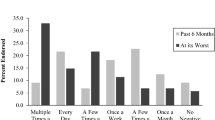Abstract
We examined the effects of long term administration of naltrexone on the severe self-injury, stereotypy, and social behavior of two women with developmental disabilities. A single-subject withdrawal design was used. Results indicated naltrexone eliminated self-injury and stereotypy, and increased smiling, eye-contact, and touch tolerance duration. Psychophysiological (finger temperature) data indicated that untreated self-injurious behavior induced vasodiolation, and that naltrexone induced a paradoxical, reversal vasoconstriction. However, finger temperature data for touch tolerance showed that the untreated condition was correlated with vasoconstriction, and treatment with naltrexone resulted in vasodiolation. Additional evaluation of the effects of naltrexone with the Aberrant Behavior Checklist (ABC) indicated that the scores on the respective ABC subscales changed in the same manner as observations of self-injury, stereotypy, and social behavior. Results are discussed in terms of the importance of opioid receptor antagonists in the treatment of self-injury, stereotypy, and reduced social responsiveness in some individuals with developmental disabilities.
Similar content being viewed by others
References
Aman, M. G. (1991). Pharmacotherapy in the developmental disabilities: New developments.Austr. New Zeal. J. Devel. Dis. 17: 183–199.
Aman, M. G., and Singh, N. N. (1986).Aberrant Behavior Checklist: Manual, Slosson Educational Publications, East Aurora, NY.
Gillberg, C. (1988). The role of the endogenous opioids in autism and possible relationships to clinical features. In Wing, L. (ed.),Aspects of Autism: Biological Research, Alden, Oxford, UK, pp. 31–37.
Gillberg, C., Tereniusm I., and Lunnerholm, G. (1985). Endorphin activity in childhood psychosis.Arch. Gen. Psychiatry 42: 780–783.
Kazdin, A. E. (1982).Single-case Research Designs: Methods for Clinical and Applied Settings, Oxford University Press, Inc., New York.
Leboyer, M., Bouvard, M. P., Launary, J. M., Tabuteau, F., Waller, D., Dugas, M., Kerdelhue, B., Lensing, P., and Panksepp, J. (1992). Brief report: A double-blind study of naltrexone in infantile autism.J. Aut. Devel. Dis. 22: 309–319.
Panksepp, J., Siviy, S., and Normansell, L. (1985). Brain opioids and social emotions., In Reite, M., & Fields, T. (eds.),The Psychobiology of Attachment and Separation, Academic Press, Orlando, FL, pp. 3–50.
Ricketts, R. W., Ellis, C. R., Singh, Y. N., and Singh, N. N. (1993). Opioid antagonists: II. Clinical effects in treatment of self-injury in individuals with developmental disabilities.J. Devel. Phys. Dis. 5: 17–28.
Ross, D. L., Klykylo, W. M., and Hitzeman, R. (1987). Reduction of elevated CSF Beta-endorphin by fenfluramine in infantile autism.Pediatr. Neurol. 3: 83–86.
Sandman, C. A. (1988). B-endorphin disregulation in autistic and self-injurious behavior: A neurodevelopmental hypothesis.Synapse 2: 193–199.
Sandman, C. A. (1990/1991). The opiate hypothesis in autism and self-injury.J. Child Adol. Psychopharmacol. 1: 237–248.
Sandman, C. A., Barron, J. L., Cinella, F. M., and Donnelly, J. F. (1987). Influence of naloxone on brain and behavior of a self-injurious woman.Biological Psychiatry 22: 899–906.
Singh, Y. N., Ricketts, R. W., Ellis, C. R., and Singh, N. N. (1993). Opioid antagonist. I: Pharmacology and rationale for use in treating self-injury.J. Devel. Phys. Dis. 5: 5–15.
Author information
Authors and Affiliations
Rights and permissions
About this article
Cite this article
Smith, S.G., Gupta, K.K. & Smith, S.H. Effects of naltrexone on self-injury, stereotypy, and social behavior of adults with developmental disabilities. J Dev Phys Disabil 7, 137–146 (1995). https://doi.org/10.1007/BF02684958
Issue Date:
DOI: https://doi.org/10.1007/BF02684958




